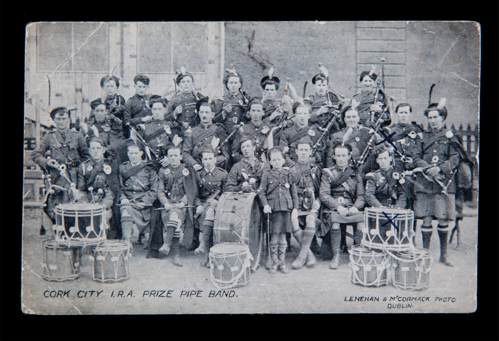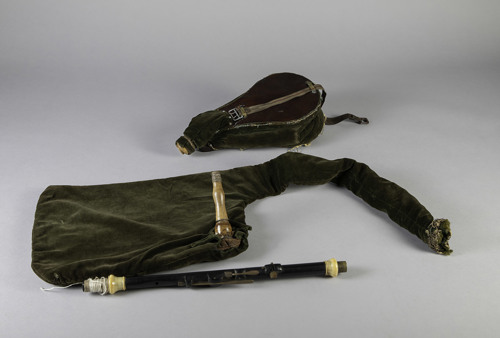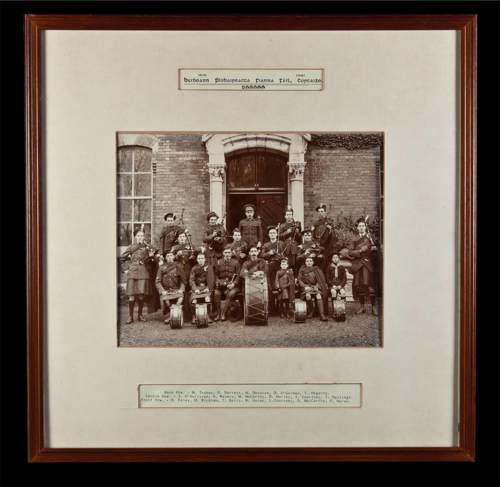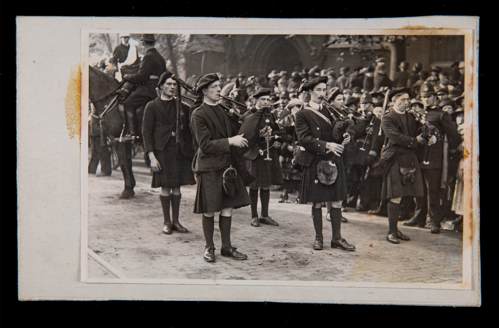Objects of Cork
A Journey Through the History of the Irish Warpipes and c Pipes
By Aoife Kelly
The rich cultural heritage of Ireland includes a vibrant tradition of music. There are many instruments unique to the Irish music tradition, one of which is particularly prominent due to its powerful and dynamic energy, substantial historical significance, and connection to Irish military action. The Irish warpipes, or píob mhór in Irish, which translates to Great Pipes, were once an inherent part of the Irish traditional music scene, tracing back as early as the eleventh century, but have since declined in use in favour of the more popular uilleann pipes. However, delving into the history of these largely forgotten warpipes reveals a fascinating narrative of a significant part of Irish cultural and martial history.
(Above) Programme Cork Pipers Club Concert 1900.
Ireland’s musical heritage is deeply intertwined with the sound of its pipes. From the inspirational and rousing call to arms of the Irish warpipes to the ornate, emotive melodies of the uilleann pipes, these instruments have shaped the country’s cultural identity for centuries. But what does their history tell us, and what is the difference between the two instruments? The Irish warpipes and uilleann pipes are both traditional Irish bagpipes, but they differ significantly in their design, sound, and use.
(Above) Photo Cork City IRA Pipe Band.
Cork Public Museum are the caretakers of a number of artifacts surrounding the pipes:
- A complete set of Irish warpipes, once belonging to Tomás MacCurtain
- A chanter (a pipe with finger holes, on which the player plays the melody) from a set of warpipes once belonging to the piper of Crossbarry, Florence ‘Flor’ Begley.
- A set of uilleann pipes once belonging to the Begley family
These artifacts are significant due to their connection with the Irish War of Independence, along with their importance regarding Irish musical heritage. Tomás MacCurtain was a former Lord Mayor of Cork for a seven week period during the war, which was cut short by his assassination by the RIC in 1920. Florence Begley was a member of the West Cork IRA - as an Assistant to the Brigade Adjutant, he would often bring his pipes to combat.
(Above) Brooch Irish Volunteers. Cork Volunteer Pipe Band Brooch. Tom O'Neill Collection.
IRA Commandant General Tom Barry said of Begley: ‘the best of soldiers will fight even better still to the strains of their traditional war songs, and the harsh wild music of the bagpipes would have a demoralising effect…’ on their English foes. It is said the Crossbarry warpipe was damaged in an attempt to hide it from the RIC, and the chanter can still be seen in the condition it was left in - broken in half. Before its breaking, it was linked to the funeral of Charlie Hurley, a Commanding Officer of the IRA who was killed the morning of the Crossbarry Ambush, a battle against the British forces in Ireland during which Begley played war tunes on his pipes. Playing music on the warpipes during the funeral of a prominent IRA officer demonstrates the link between the instrument and Irish rebellion.
(Above) The chanter from the Crossbarry war pipes, part of the Cork Public Museum collection
The Irish warpipes were traditionally used in battle, marches, parades, funerals, dances, and outdoor sporting events. They were loud and commanding, and were played mostly outdoors as their sound was powerful, designed to travel over long distances. They made their first appearance in the eleventh century, which was pre-Norman Ireland, but did not become common until the sixteenth century; Tudor Ireland. Typically, they had one or two drones and a chanter, and were played by blowing air directly into the bag through a mouthpiece. Their playing style was less ornamented than the uilleann pipes, more suited for marches and martial tunes. There are many historical references to the Irish warpipes in a military context, with Irish pipers accompanying soldiers to war even on the continent, such as during the siege of Boulogne in 1544. In Ireland they were used to accompany Irish chiefs to battle, or to carry out cattle raids on neighbouring territories. The pipes were a part of the military establishment during the Irish Rebellion of 1641, the Cromwellian and Williamite wars, and even during the Whiteboy disturbances of the 1760s. It was also used extensively during the revolutionary years of the War of Independence against British rule in Ireland. The native Irish warpipe tradition seems to have faded in popularity and was lost during the late 1700s, but featured a revival during the early decades of the 1900s, and can still be seen played today.
(Above) Photo Group Fianna Fail Pipe Band Cork 1921.
(Above) Illustrated London News. Irish Piper in Patrick Street Cork 1852.
The 18th century saw the emergence of a new, distinctly Irish form of piping instrument, the uilleann pipes, otherwise known as the union pipes, which would be played sitting down, unlike the standing / marching custom that went with the warpipes. Additionally, unlike the warpipes which were mouth-blown, the uilleann pipes were played using a bellows strapped to the arm, which would be pumped with air by moving the elbow up and down, hence the name uilleann pipes (‘uilleann’ being the Irish word for elbow). The uilleann pipes were primarily used for Irish traditional music, often played indoors or in smaller gatherings. They quickly replaced the warpipes in providing music for dancing. Their sound was softer, more mellow, and more melodic, capable of dynamic expression. The construction of the instrument is more complex, with a chanter which allows for a larger range of notes than the warpipes (two octaves compared to only nine notes), along with (typically) three drones and three regulators that provide chordal accompaniment. The playing style is highly ornamented, featuring intricate rolls, cuts, pops, and crans, as well as vamping and vibrato. The chanter allows for a range of dynamics and even some polyphony with the regulators. The medium of Irish traditional musical expression for hundreds of years, they have been credited with shaping the music of the country in a very considerable way.
(Above) War Pipes owned by Tomas MacCurtain
In modern Irish history, music was a constant presence in Irish political life with pipes, fiddles and rebel songs all playing a part in the nationalist movement, serving as both a means of cultural expression and a tool for resistance. The idea that traditional music represented an idealised, radical and absolute nationalism, perpetuated by the Fenians, parliamentarians, land reformers and cultural revivalists, among others, was well established and entrenched in Irish society, along with the social practice of expressing ideology and intimidating opponents through collective public music, notably in public parades. These connotations would have significant implications for the revolutionaries of the War of Independence in their attitudes and how they conceived and practised nationalist politics. The Irish warpipes went through a revival as Ireland approached revolution in the 1910s, and thus became enmeshed with national politics, with pipe players who were members of the IRB or the IRA using their music as a way to inspire and and encourage their comrades when facing terrifying confrontations, filling them with the strength to go on. Songs featuring a rousing call to arms were highly popular among nationalists, as were marching tunes which inspired resistance, and accompanied advancing soldiers to battle. This use of the instrument in Irish military history has been compared to the call of the trumpet used to stir soldiers during battle by other nations.
(Above) The Piper Major by Gladys Scott. Molly Cronin Collection.
The war pipes were the soundtrack of Irish rebels and soldiers, piercing and forceful, while the uilleann pipes developed into a refined, expressive instrument used in Ireland to this very day. The history of these pipes tells a story of war and rebellion, of artistry and tradition, and of a people who have carried their music through hardship, oppression, and triumph.
(Above) Photo Group IRA Irish Republican Army Prize Pipe Band Cork. Oireachteas Prize Winners 1918-19
For more information on the subject, see
Barry, Tom. Guerilla Days in Ireland. Irish Press, 1949.
Breathnach, Breandán. Folk Music and Dances of Ireland. Mercier Press, 1971.
Cadogan, Tim, and Jeremiah Falvey. A Biographical Dictionary of Cork. Four Courts Press, 2006.
Ó Canainn, Tomás. Traditional Music in Ireland. Routledge & Kegan Paul, 1978.
O’Neill, Francis. Irish Minstrels and Musicians. Regan Printing House, 1913.
Parfitt, Richard. ““Oh, what matter, when for Erin dear we fall?”: music and Irish nationalism, 1848–1913.” Irish Studies Review 23, no. 4 (2015): 480-494.
Vallely, Fintan. The Companion to Irish Traditional Music. Cork University Press, 2024.
White, Harry, and Barra Boydell. The encyclopaedia of music in Ireland. University College Dublin Press, 2013.
Williams, Sean. Focus: Irish Traditional Music. Taylor & Francis Group, 2020.
(Above) Photo Terence MacSwiney's Funeral Pipe Band. Brixton London 1920.












